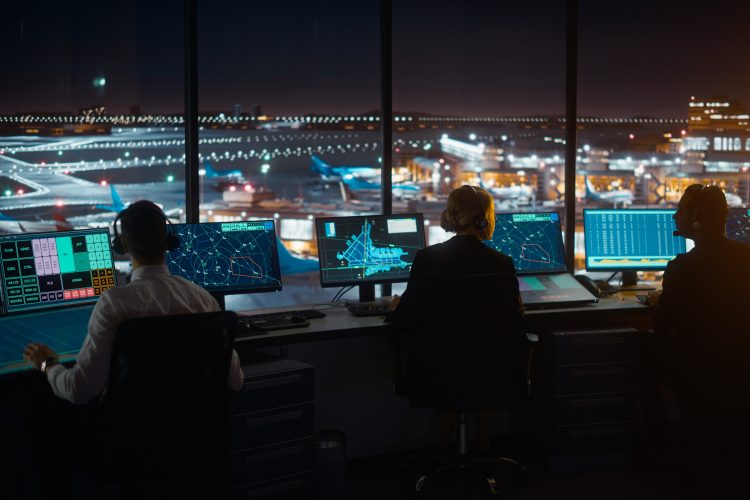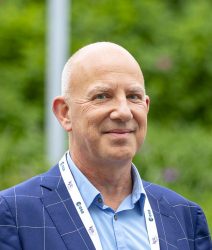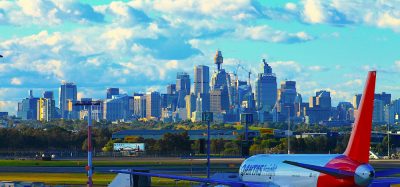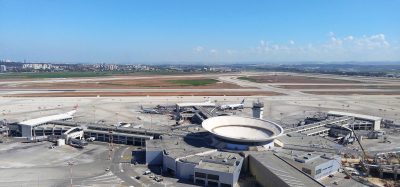In the radar room with Bart Banning, ATM Architect
- Like
- Digg
- Del
- Tumblr
- VKontakte
- Buffer
- Love This
- Odnoklassniki
- Meneame
- Blogger
- Amazon
- Yahoo Mail
- Gmail
- AOL
- Newsvine
- HackerNews
- Evernote
- MySpace
- Mail.ru
- Viadeo
- Line
- Comments
- Yummly
- SMS
- Viber
- Telegram
- Subscribe
- Skype
- Facebook Messenger
- Kakao
- LiveJournal
- Yammer
- Edgar
- Fintel
- Mix
- Instapaper
- Copy Link
Posted: 14 August 2024 | International Airport Review | No comments yet
Bart Banning, Air Traffic Management (ATM) Architect at Luchtverkeersleiding Nederland (LVNL), the agency in charge of air traffic control in the airspace of the Netherlands, speaks to International Airport Review about what he is working on; how the ATM industry must attract the next generation and the new technology he is excited about.


Bart Banning, please tell us about yourself and your role with LVNL.
Bart Banning: I call myself an ATM Architect, so I am looking at future developments of our air traffic control (ATC) system to see what new technologies we can embrace, how we evolve from where we are now to new ways of working, especially taking into account our paying customers, the airlines, and the environment, as well.
There’s no shortage of technical equipment and software, but we must be selective to see what’s really going to help us in our particular situation. Personally, I would say that some of the products sold by ATM solution providers do not immediately solve our problems.
Most companies have a reasonable level of understanding of our business, but it’s not always so obvious how to solve the practical and technical issues.
What do you think is required to have a long and lasting career in air traffic management?
That’s really an interesting question.
Usually, as an Air Traffic Controller you are selected at a young age, and the selection and training process is very hard. You must have exactly the right skills, and once you prove that you are fit for it, well then you usually stay for life.
For all the other jobs, I think ATM is not so different from other sectors at the moment. There are staff shortages everywhere. At LVNL, I’ve never seen so many vacancies! We’re doing our best to try to attract and interest people.
Of course, we have a slight disadvantage in that we normally require people to know Dutch or to learn Dutch, so that makes it a little bit harder. But we are especially looking for a lot of Technicians and IT personnel for our headquarters near Amsterdam.
Young people do not seem to be so interested in ATC/ATM roles and many of my colleagues say: “When I ask my kid, ‘What do you want to be, a fireman or a pilot?’, they say, ‘No. I want to be an influencer or a YouTuber, or maybe a DJ if everything else fails.'”
However, young people are interested in technology and I’m sure we will reach a moment in time when everything is managed by computers. We are now at a point where we can say to our new ATC recruits, “We’re not sure if you’ll be doing the same routine all your life, because developments are going quite fast with artificial intelligence and quantum computers, and all of this new technology.”
LVNL makes a lot of effort to attract new people to the profession with Ladies Nights where women can meet and network with women in the profession and experience days which make up the ‘Week of LVNL’, where we invite people to our premises and we have a whole week of events and talks and excursions, and everything we could possibly think of really, to attract people to come to our company, to visit a department of their choice, or come and see how we work.
That same week, we are organising a fair, where we have all kinds of games and events to attract students, but also people from all walks of life, all industries. If they feel like they would like to be part of our organisation, then they’re more than welcome to get to know it a little bit better.
What has kept you in the industry for so long? What is it that really captures your imagination?
I think it’s quite a fascinating business and aviation has some attraction to it. However, I wouldn’t say it’s very advanced. Before I joined, I was in commercial shipping and when I came to this industry, I realised everything was 10 years behind in aviation. Of course, because of the safety aspects, you must prove and certify everything two or three times before it’s accepted.
But nevertheless, we have many challenges. It’s a very operational environment. We have all kinds of stakeholders, from the very small airspace users to the very large ones. Flying and the internet are the two things that have connected the world.
Flying and the internet are the two things that have connected the world”
What benefits does LVNL offer as an employer?
We receive 27 days of vacation (with full-time employment), holiday pay, an end-of-year bonus and a contribution to the costs of our health insurance.
LVNL encourages flexible and hybrid working, for which you receive a work-from-home allowance. Travel costs are partially reimbursed and commuting by public transport or bicycle is fully reimbursed.
At Schiphol-Oost we also have a company restaurant where we can have breakfast, lunch and dinner. There is also a fitness room that can be used 24/7.
LVNL recognises the importance of investing in its employees and offers various opportunities to stimulate personal development. There is an LVNL Academy where you can follow various courses and training. In addition, the employee purpose programme and the leadership purpose programme start every year, with which you can follow various workshops. In many cases, training courses are fully reimbursed.
How are you working to ensure sustainable flight paths for your airlines?
For the last two decades, I’ve been obsessed by trying to help introduce continuous descent operations (CDO) like flight idle from top of descent, just a glide into the airport. With that you hardly spend any fuel and make the least noise possible. I never get tired of trying to chase that future way of operating.
I never get tired of trying to chase that future way of operating”
What we do on a day-to-day basis, is try to introduce shorter routes with curved approaches or curved departures, trying to stay away from built-up areas, making use of performance-based navigation and other advanced CNS solutions. But we found that you can only do it step-by-step, taking everything into account you can think of testing, trying again, training, starting from scratch. It all happens with baby steps.
What do you think is standing in the way of airspace modernisation?
Human nature. As humans, we fear change, and we are reluctant to embrace new technology. It’s not only technologies such as AI, but also everything that’s different from what we’re used to. When we begin a project, it’s usually starts with a list of 100 things why we shouldn’t do it or why it’s difficult or why it’s unsafe or un-secure. And usually, after the fact, when finally, something is introduced, then you don’t hear those people anymore.
As humans, we fear change, and we are reluctant to embrace new technology”
Some of the concerns you have engineered away, or you found solutions, but also some concerns never materialised either because they were not real risks or threats. Or it was just things in people’s minds that kept them from advancing. The human mind is risk-averse and therefore we can get in our own way of progress.
The human mind is risk-averse and therefore we can get in our own way of progress”
How are you collaborating with other entities to improve ATM in the Netherlands?
We are collaborating in a typical Dutch way, sitting around the table and talking with all the players and all the stakeholders. We don’t have a mindset of putting everything in a contract and letting the legal people look at it. Of course, sometimes it’s a necessary step, but we like to talk about the issues, try to come up with practical ways to solve them, and give everybody their responsibility to try and come up with a solution together.
What technology is going to be disrupting the ATC/ATM space most in the coming years? What are the ones that you are really excited about?
I was really excited about satellite navigation, GNSS (global navigation satellite systems) and performance-based navigation. We’ve taken very large steps with that in our country. And I’m hoping that the next one will be satellite communication. So, a lot more data link, data communication between parties, both on the ground and in the air.
We are seeing some very nice new players, like the IRIS satcom system, which I’m looking forward to. We are advancing in ATC systems in navigation and surveillance, especially with ADS (automatic dependent surveillance). But communication was almost a missing link, and we were relying so much on old-fashioned systems. So, I hope we’re going to see a big leap forward, there. I can hardly wait to have a high-speed datalink with the cockpit.
What are you most excited about? What’s on your personal to-do list, in your role?
What I’m most excited about right now is a new concept that we’re thinking of for night operations. I am sure you saw in the news that our politicians and even our airports were talking about reducing the number of flights and late-night flights in order to make it more sustainable and less noisy for the future.
There might be a reduction in the number of flights in the night, but also, because of staffing issues, LVNL would like to reduce the number of controllers in the night. We have been working on a new concept of handling the traffic, by sending everybody to a common point over the North Sea and let them intercept a final CDO from there.
We came to a point where we wanted to do some simulations. I think now’s the time that we can take this up, and maybe get it to work, in order to have a more efficient operation during our nighttime. In the daytime, our priority is capacity, but in the night our priority is avoiding nuisance.
So that new concept will be based on continuous descent with as little noise as possible. Less aircraft with less noise, combined, should make a big improvement.


Bart Banning is a thought leader in airspace innovation with extensive operational and technical experience. He has a special interest in the advanced use of satellites in ATM/CNS applications. He started his career at LVNL as a Flight Inspector and subsequently became a Manager in the technical department. He then proceeded to instrument flight procedure design and is currently an Architect in performance and development. He is involved in various international working groups and is also an organiser of the European Navigation Conference.
More Like This


















